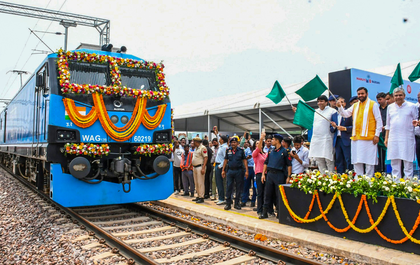India’s logistics sector to clock 10.7 pc growth till 2026, create millions of jobs: Centre
By IANS | Updated: August 16, 2025 14:25 IST2025-08-16T14:16:56+5:302025-08-16T14:25:12+5:30
New Delhi, Aug 16 India’s logistics sector, valued at $215 billion in 2021, is well-positioned for strong growth ...

India’s logistics sector to clock 10.7 pc growth till 2026, create millions of jobs: Centre
New Delhi, Aug 16 India’s logistics sector, valued at $215 billion in 2021, is well-positioned for strong growth with an expected compound annual growth rate (CAGR) of 10.7 per cent till 2026, government data showed on Saturday.
The government’s decision to grant the sector infrastructure status has enabled access to cheaper, long-term funding, similar to roads and railways, further solidifying its significant role in the growth story of India.
Several government initiatives like the National Logistics Policy (NLP), PM GatiShakti, GST and Logistics Parks are modernising infrastructure and cutting costs.
“The sector employs over 22 million people and is creating millions of new jobs. Inland Waterways reported a record cargo of 145.5 million tonnes for 2024–25. Digitalisation and tech platforms like ULIP are boosting efficiency and transparency across supply chains,” according to the official data.
India stands as the fourth-largest economy in the world. Different sectors, including the service, manufacturing, and agriculture, led India’s strong recovery after the pandemic in 2021 and 2022, resulting in 15.3 per cent growth over the two years.
India has since maintained its status as the world’s fastest-growing major economy, with a real GDP growth rate (at constant prices) of 6.5 per cent in the year 2024-2025.
Stronger supply chains today mean a stronger, more resilient India tomorrow. The government’s push for infrastructure development and digitalization has further accelerated growth, establishing India as a key logistics hub in Asia.
In July 2017, a separate logistics unit was created under the Department of Commerce to oversee the Integrated Development of Logistics Sector.
The National Logistics Policy (NLP) was launched in September 2022 to create a more seamless logistics ecosystem by improving efficiency and reducing logistics costs. As part of this reform, digital initiatives like the Unified Logistics Interface Platform (ULIP) and the Logistics Data Bank (LDB) are now fully operational, aiming to enhance ease of doing business and enable tracking of containerized Export Import (EXIM) cargo.
PM GatiShakti Master Plan was launched in October 2021 to integrate different modes of transport into a coordinated network. The PM GatiShakti has brought together 57 Central Ministries/Departments and all 36 states and union territories. It has also integrated massive 1,700 data layers, creating a truly unified and comprehensive platform for infrastructure planning.
The Ministry of Railways is currently developing two Dedicated Freight Corridors (DFCs), namely, the Eastern Dedicated Freight Corridor(EDFC) from Ludhiana to Sonnagar (1,337 km) and the Western Dedicated Freight Corridor (WDFC) from Jawaharlal Nehru Port Terminal (JNPT) to Dadri (1,506 km).
Out of the total 2,843 kms, 2741 Route Kilometers (96.4 per cent) are operational as of March 2025. The corridors are expected to accelerate industrial development and create significant employment opportunities in logistics and related sectors.
Disclaimer: This post has been auto-published from an agency feed without any modifications to the text and has not been reviewed by an editor
Open in app